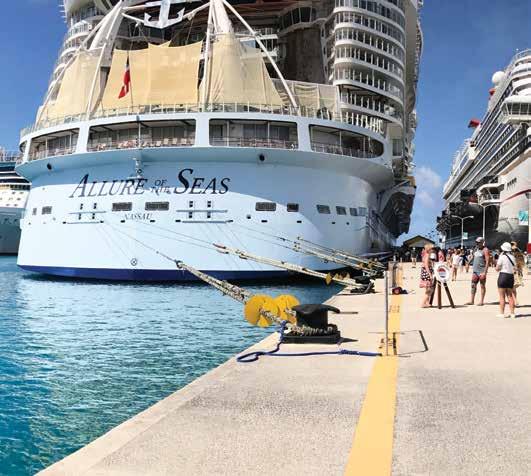
4 minute read
St. Maarten’s Return to Prominence and Lessons for Other Cruise Destinations
By MICO CASCAIS, Principal, Mico Cascais Inc., Veteran Shore Excursions Executive & Destination Experience Expert
For many years St. Maarten has been the prominent destination in the Eastern Caribbean, with stateof-the-art port Facilities, the allure of two nations in one island, 37 square miles with 37 magnificent beaches, friendly people and diverse choices available for all guests’ demographics to enjoy and maximize their experience during their visit. As a matter of fact, it would be considered a prominent destination anywhere.
Advertisement
As a cruise executive, traveling to Caribbean destinations was a significant part of my scope of responsibility, either as the Carnival Cruise Line’s shore excursions business owner or part of the FCCA Operations Team, we engaged the stakeholders—both the public and private sectors—in order to ensure delivery of the best overall passenger experience of the destination, even down to checking if the garbage pick-up time coincides correctly with ship arrivals so passengers see clean streets. In my opinion, these destination ambassadors and the many stories they and each destination can tell collectively form the overall experience cruise guests desire today.
St. Maarten was always a go-to reference when often asked, “What destination does it right?” With that said, leadership puts you in a position of constantly being challenged by your neighboring destinations, just like a sports team that wins the league title and sees everyone striving to play better against them the next season.
But great teams also always look to improve, even after winning the title, and the Port St. Maarten executive management team had already taken the position of looking ahead to the future both in infrastructure and the overall guest experience. The parallel efforts of better infrastructure and guest experience were well underway when on September 6, 2017 Hurricane Irma made a direct hit on St. Maarten with catastrophic results in some areas.
The traumatic experience of going through a Category 5+ hurricane was palpable within the content of any dialogue, and the stories were both heroic and horrific. The weeks to follow were difficult, as uncertainty became a common topic, especially as it pertained to when cruise ships would return. For a destination so dependent on cruise tourism, there was no time to be discouraged by the catastrophic impact.
It was time to go to work and unite all stakeholders with a focused common goal: bring St. Maarten back to not just its previous prominence, but better than ever, one step at a time. The Port team and I collaborated on an aggressive approach, starting with two consecutive days of educational workshop sessions that brought in hundreds of stakeholders from both the public and private sectors—all were invited to attend. What happen next was truly remarkable and will positively impact St. Maarten for years to come.


It was evident at first that not all were sure of their role or impact on the cruise sector or how the cruise sector affected them personally. This soon changed as each gained a better understanding of the industry as a business, its economic impact on a destination and what cruise lines and passengers expect of a destination.
The understanding and significance of each individual’s role on the delivery of the destination’s experience became clearer and clearer with each workshop; it was truly humbling to see the awareness that was taking place, and everyone wanted to know more about how to better play their role to ensure the first critical calls were a great success.
The two-week sprint was born, as it was exactly two weeks prior to the first planned cruise call, and both the public and private sectors positioned themselves to execute their roles according to the actionable list of items needed to deliver the expected experience.
The sense of unity and collaboration was palpable—and visible, with tour opera tors laying down bricks on Front Street and dozens of stakeholders organizing clean ups. These were many working as one, which continuous today. Currently, the cruise guests experience is progressing nicely toward the pre-hurricane experiences. This in itself was a remarkable feat only possible due to the resilience, renewed work ethic and under standing that their success is directly dependent on the success of their neighbors—and even competitors. Everyone is needed to tell the stories that deliver the experience.
And what stories St. Maarten has to tell! From its first inhabitants—the Ciboney, the Arawak and the Carib Indians—to the salt trading days, colonial times and even today’s authentic and/or
off-the-beaten-path experiences that are

sought out by both well-traveled guests and first-timers: the diverse and enthusiastic stakeholders are now ready to tell these stories, and to incorporate them into everything from the infrastructure to new and refined experiences.
I am truly excited for the people for St. Maarten and the Port of St. Maarten; they have the right momentum needed to capitalize on the industry’s growth. The activation of citizens as destination ambassadors, along with their stories and the new and improved experiences will continue to keep St. Maarten as a leading destination of choice in the Caribbean. And I urge other destinations to consider this story—and the stories they can tell— when considering how to build momentum of their own.










